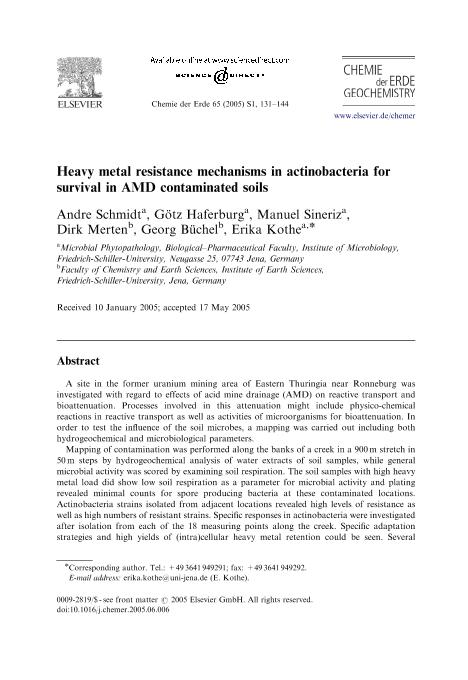Mostrar el registro sencillo del ítem
dc.contributor.author
Schmidt, Andre
dc.contributor.author
Haferburg, Götz
dc.contributor.author
Siñeriz Louis, Manuel

dc.contributor.author
Merten, Dirk
dc.contributor.author
Büchel, Georg
dc.contributor.author
Kothe, Erika

dc.date.available
2018-08-23T15:55:02Z
dc.date.issued
2005-09
dc.identifier.citation
Schmidt, Andre; Haferburg, Götz; Siñeriz Louis, Manuel; Merten, Dirk; Büchel, Georg; et al.; Heavy metal resistance mechanisms in actinobacteria for survival in AMD contaminated soils; Elsevier Gmbh, Urban & Fischer Verlag; Chemie Der Erde; 65; SUPPL. 1; 9-2005; 131-144
dc.identifier.issn
0009-2819
dc.identifier.uri
http://hdl.handle.net/11336/56810
dc.description.abstract
A site in the former uranium mining area of Eastern Thuringia near Ronneburg was investigated with regard to effects of acid mine drainage (AMD) on reactive transport and bioattenuation. Processes involved in this attenuation might include physico-chemical reactions in reactive transport as well as activities of microorganisms for bioattenuation. In order to test the influence of the soil microbes, a mapping was carried out including both hydrogeochemical and microbiological parameters. Mapping of contamination was performed along the banks of a creek in a 900 m stretch in 50 m steps by hydrogeochemical analysis of water extracts of soil samples, while general microbial activity was scored by examining soil respiration. The soil samples with high heavy metal load did show low soil respiration as a parameter for microbial activity and plating revealed minimal counts for spore producing bacteria at these contaminated locations. Actinobacteria strains isolated from adjacent locations revealed high levels of resistance as well as high numbers of resistant strains. Specific responses in actinobacteria were investigated after isolation from each of the 18 measuring points along the creek. Specific adaptation strategies and high yields of (intra)cellular heavy metal retention could be seen. Several strategies for coping with the high heavy metal contents are further discussed and genes for proteins expressed specifically under high nickel concentration were identified by two-dimensional gel electrophoresis. © 2005 Elsevier GmbH. All rights reserved.
dc.format
application/pdf
dc.language.iso
eng
dc.publisher
Elsevier Gmbh, Urban & Fischer Verlag

dc.rights
info:eu-repo/semantics/openAccess
dc.rights.uri
https://creativecommons.org/licenses/by-nc-sa/2.5/ar/
dc.subject
Actinobacteria
dc.subject
Amd
dc.subject
Bioavailable Heavy Metals
dc.subject
Bioremediation
dc.subject
Heavy Metal Resistance
dc.subject
Molecular Biology
dc.subject
Proteome Analysis
dc.subject
Soil Extract
dc.subject
Streptomycetes
dc.subject.classification
Meteorología y Ciencias Atmosféricas

dc.subject.classification
Ciencias de la Tierra y relacionadas con el Medio Ambiente

dc.subject.classification
CIENCIAS NATURALES Y EXACTAS

dc.title
Heavy metal resistance mechanisms in actinobacteria for survival in AMD contaminated soils
dc.type
info:eu-repo/semantics/article
dc.type
info:ar-repo/semantics/artículo
dc.type
info:eu-repo/semantics/publishedVersion
dc.date.updated
2018-08-21T13:55:13Z
dc.journal.volume
65
dc.journal.number
SUPPL. 1
dc.journal.pagination
131-144
dc.journal.pais
Alemania

dc.journal.ciudad
Jena
dc.description.fil
Fil: Schmidt, Andre. Friedrich Schiller University; Alemania
dc.description.fil
Fil: Haferburg, Götz. Friedrich Schiller University; Alemania
dc.description.fil
Fil: Siñeriz Louis, Manuel. Consejo Nacional de Investigaciones Científicas y Técnicas; Argentina. Friedrich Schiller University; Alemania
dc.description.fil
Fil: Merten, Dirk. Friedrich Schiller University; Alemania
dc.description.fil
Fil: Büchel, Georg. Friedrich Schiller University; Alemania
dc.description.fil
Fil: Kothe, Erika. Friedrich Schiller University; Alemania
dc.journal.title
Chemie Der Erde

dc.relation.alternativeid
info:eu-repo/semantics/altIdentifier/doi/https://dx.doi.org/10.1016/j.chemer.2005.06.006
dc.relation.alternativeid
info:eu-repo/semantics/altIdentifier/url/https://www.sciencedirect.com/science/article/pii/S0009281905000486
Archivos asociados
